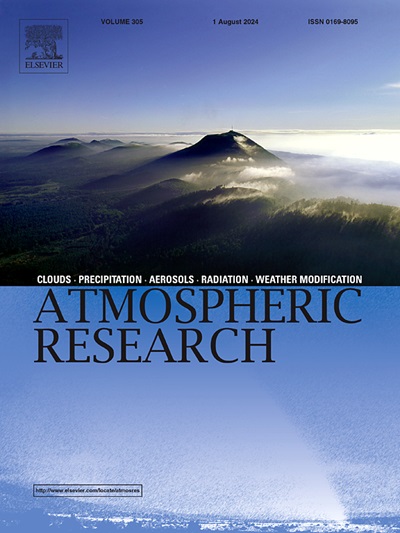Observational study of a quasi-stationary mesoscale convective system during extreme rainfall on 8 August 2022 in Korea
IF 4.5
2区 地球科学
Q1 METEOROLOGY & ATMOSPHERIC SCIENCES
引用次数: 0
Abstract
On 8 August 2022, a quasi-stationary mesoscale convective system (MCS) produced prolonged extreme rainfall (> 100 mm h−1) over the Seoul metropolitan area, Republic of Korea. These organized convective systems, primarily composed of convective components with interspersed stratiform elements, are characterized by the successive local generations of convective cells. This study analyzes data from multiple observational platforms to understand the formation of the MCS and its microphysical evolution. The convective cells were initiated just off the west coast near Seoul, along the boundary between warm and cold air masses. Low-level convergence and favorable environmental conditions, including low lifting condensation level, level of free convection, and large convective available potential energy, facilitated the triggering of these cells. As the cells moved inland, they intensified rapidly due to the land-sea surface-friction contrast. Radar data show that as the MCS matured, reflectivity increased and the differential reflectivity decreased downward above the melting level, indicating the growth of ice crystals and graupels. The evolution of microphysical structure led to increases in both the mean diameter (Dm) and the number concentration (NT) of raindrops. This observation also suggests that the rainfall intensity was more closely related to the increase in NT than Dm during the period of heavy downpours. This study improves our understanding of the mesoscale processes related to extreme rainfall in Korea, critical for forecasting local heavy rainfall.
2022年8月8日韩国极端降水过程中准平稳中尺度对流系统的观测研究
2022年8月8日,一个准平稳的中尺度对流系统(MCS)产生了长时间的极端降雨(>;大韩民国首尔市区上空100毫米h−1)。这些有组织的对流系统主要由对流成分和穿插的层状成分组成,其特征是局部连续几代的对流单体。本研究分析了多个观测平台的数据,以了解MCS的形成及其微物理演化。对流单体是在首尔附近的西海岸,沿着冷暖气团的边界形成的。低层辐合和较低的上升凝结水平、自由对流水平、较大的对流有效势能等有利的环境条件有利于这些单体的触发。当风暴单体向内陆移动时,由于陆-海表面摩擦的对比,它们迅速增强。雷达数据显示,随着MCS的成熟,反射率增加,而在融化水平以上,差反射率向下下降,表明冰晶和霰的生长。微物理结构的演化导致雨滴平均直径(Dm)和雨滴数浓度(NT)的增加。这一观测结果还表明,在强降水期间,降雨强度与NT的增加关系比与Dm的增加关系更密切。这项研究提高了我们对与韩国极端降雨相关的中尺度过程的理解,这对预测当地强降雨至关重要。
本文章由计算机程序翻译,如有差异,请以英文原文为准。
求助全文
约1分钟内获得全文
求助全文
来源期刊

Atmospheric Research
地学-气象与大气科学
CiteScore
9.40
自引率
10.90%
发文量
460
审稿时长
47 days
期刊介绍:
The journal publishes scientific papers (research papers, review articles, letters and notes) dealing with the part of the atmosphere where meteorological events occur. Attention is given to all processes extending from the earth surface to the tropopause, but special emphasis continues to be devoted to the physics of clouds, mesoscale meteorology and air pollution, i.e. atmospheric aerosols; microphysical processes; cloud dynamics and thermodynamics; numerical simulation, climatology, climate change and weather modification.
 求助内容:
求助内容: 应助结果提醒方式:
应助结果提醒方式:


